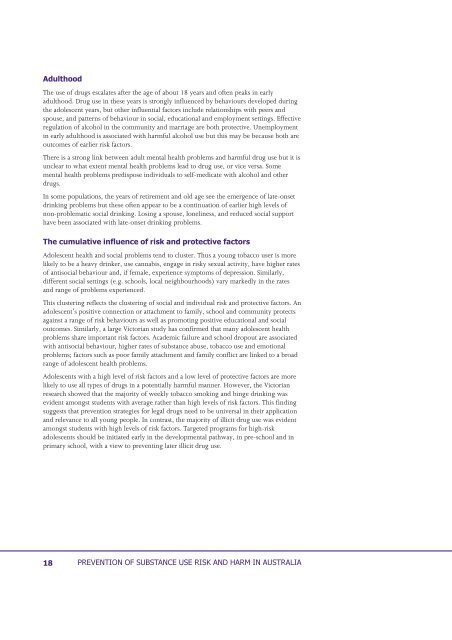Summary - Department of Health and Ageing
Summary - Department of Health and Ageing
Summary - Department of Health and Ageing
Create successful ePaper yourself
Turn your PDF publications into a flip-book with our unique Google optimized e-Paper software.
The use <strong>of</strong> drugs escalates after the age <strong>of</strong> about 18 years <strong>and</strong> <strong>of</strong>ten peaks in early<br />
adulthood. Drug use in these years is strongly influenced by behaviours developed during<br />
the adolescent years, but other influential factors include relationships with peers <strong>and</strong><br />
spouse, <strong>and</strong> patterns <strong>of</strong> behaviour in social, educational <strong>and</strong> employment settings. Effective<br />
regulation <strong>of</strong> alcohol in the community <strong>and</strong> marriage are both protective. Unemployment<br />
in early adulthood is associated with harmful alcohol use but this may be because both are<br />
outcomes <strong>of</strong> earlier risk factors.<br />
There is a strong link between adult mental health problems <strong>and</strong> harmful drug use but it is<br />
unclear to what extent mental health problems lead to drug use, or vice versa. Some<br />
mental health problems predispose individuals to self-medicate with alcohol <strong>and</strong> other<br />
drugs.<br />
In some populations, the years <strong>of</strong> retirement <strong>and</strong> old age see the emergence <strong>of</strong> late-onset<br />
drinking problems but these <strong>of</strong>ten appear to be a continuation <strong>of</strong> earlier high levels <strong>of</strong><br />
non-problematic social drinking. Losing a spouse, loneliness, <strong>and</strong> reduced social support<br />
have been associated with late-onset drinking problems.<br />
<br />
Adolescent health <strong>and</strong> social problems tend to cluster. Thus a young tobacco user is more<br />
likely to be a heavy drinker, use cannabis, engage in risky sexual activity, have higher rates<br />
<strong>of</strong> antisocial behaviour <strong>and</strong>, if female, experience symptoms <strong>of</strong> depression. Similarly,<br />
different social settings (e.g. schools, local neighbourhoods) vary markedly in the rates<br />
<strong>and</strong> range <strong>of</strong> problems experienced.<br />
This clustering reflects the clustering <strong>of</strong> social <strong>and</strong> individual risk <strong>and</strong> protective factors. An<br />
adolescent’s positive connection or attachment to family, school <strong>and</strong> community protects<br />
against a range <strong>of</strong> risk behaviours as well as promoting positive educational <strong>and</strong> social<br />
outcomes. Similarly, a large Victorian study has confirmed that many adolescent health<br />
problems share important risk factors. Academic failure <strong>and</strong> school dropout are associated<br />
with antisocial behaviour, higher rates <strong>of</strong> substance abuse, tobacco use <strong>and</strong> emotional<br />
problems; factors such as poor family attachment <strong>and</strong> family conflict are linked to a broad<br />
range <strong>of</strong> adolescent health problems.<br />
Adolescents with a high level <strong>of</strong> risk factors <strong>and</strong> a low level <strong>of</strong> protective factors are more<br />
likely to use all types <strong>of</strong> drugs in a potentially harmful manner. However, the Victorian<br />
research showed that the majority <strong>of</strong> weekly tobacco smoking <strong>and</strong> binge drinking was<br />
evident amongst students with average rather than high levels <strong>of</strong> risk factors. This finding<br />
suggests that prevention strategies for legal drugs need to be universal in their application<br />
<strong>and</strong> relevance to all young people. In contrast, the majority <strong>of</strong> illicit drug use was evident<br />
amongst students with high levels <strong>of</strong> risk factors. Targeted programs for high-risk<br />
adolescents should be initiated early in the developmental pathway, in pre-school <strong>and</strong> in<br />
primary school, with a view to preventing later illicit drug use.

















